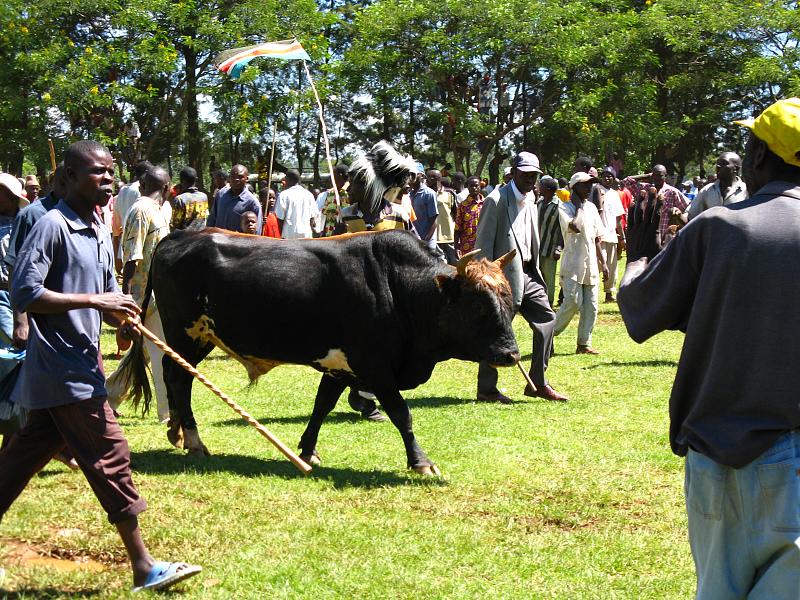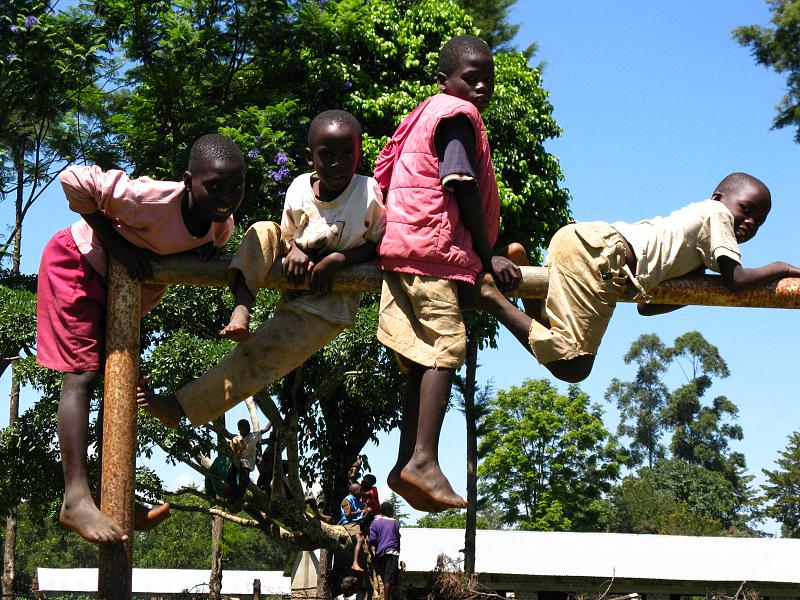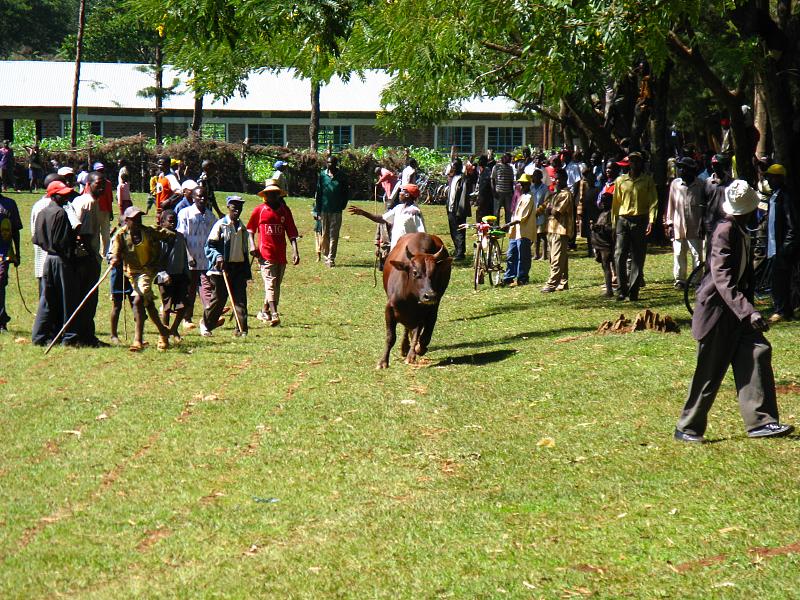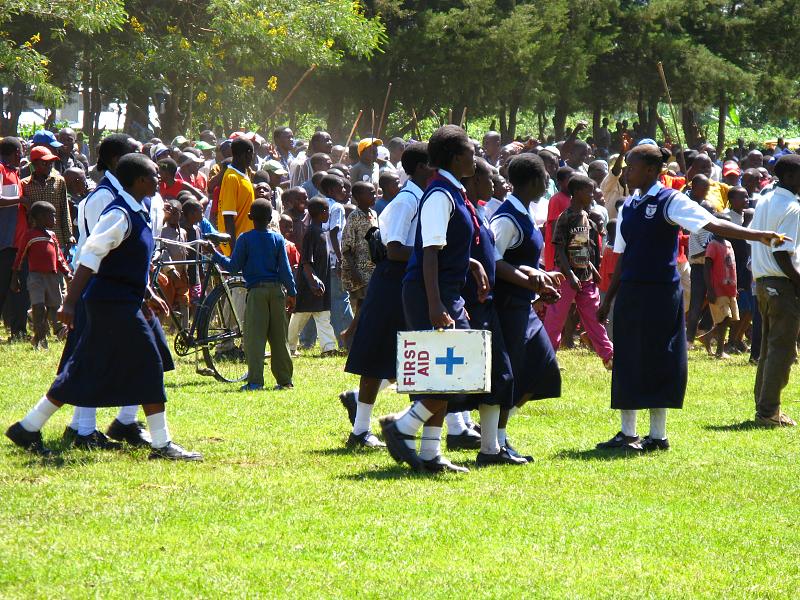Probably, you think you know bullfighting. That it’s a tradition that takes place in Spain. That it involves a matador, a red cape, and a bull being put to death while spectators watch on from the safety of distant stands. But that is only one version of the story. For there is another bullfighting, too, in Kenya, and it is nothing like the Spanish variety.

A champion bull on parade (Photo: meaduva via Flickr/ CC BY 2.0)
In East Africa, when people talk of bullfighting, they mean two bulls being pit against each other, closely surrounded by fans risking their lives to cheer on their champions. It hardly has rules, though each match carries immense cultural connotations. In Western Kenya around Kakamega county, bullfighting is a cultural sports venture that has existed since pre-colonial times.
I decided to attend one of the matches; to experience the exhilaration, pomp, and colour that accompanies them.
I have never seen a bullfight, and I am nervous about what to wear in case it aggravates the bulls. One thing’s for certain: I’m avoiding red. Eventually, I settle on black. I leave Nairobi at 11pm.
Within six hours, I have landed in Kakamega, and I head to the homestead of one of the organizers in Busulwa Village, the home of Messi, one of the two participating bulls, named of course after the legendary Argentinian footballer. Preparations are in high gear. Today’s match will be between Messi and a bull called Simba, Swahili for lion, who is from a village a little further from here. Fans are already blowing loud blaring horns, and villagers are playing Isukuti drums, native to the Luhya tribe who occupy Kakamega town and a huge chunk of Western Kenya.
There are other celebrations, too, and it’s a glorious occasion. However, I can’t help but notice that women have given the festivities a wide berth.
“It is bad luck for the owners of the bulls to copulate with their wives a night before the match,” an elder called Mzee Matias informs me.
The singing and celebrations continue and Matias shouts over them to fill me in about the bulls’ diet.
“They are normally given a lot of Napier grass, water, maseke (millet residue from busaa brew), and bhang,” he says. I wonder aloud why they give the bulls bhang. “Marijuana makes the bull aggressive, and it also gives it some sense of bravado for the impending match,” Matias says smiling.
The animals are always well-fed, especially during the night that precedes the match, when the handlers and their owners also drink a lot themselves, favouring large quantities of chang’aa and busaa, the traditional alcoholic brews that are native to the entire Western region of Kenya.
“The drink makes them swift and light, this encourages them to escort the bull bravely,” Matias informs me.

Kids climb for the best view of the fight (Photo: meaduva via Flickr/ CC BY 2.0)
The match will take place at Bukhungu Stadium, where either of the bulls stands to win a Kshs25,000 stake (about $200). A pickup arrives to carry Messi and his fans to the stadium which is around five kilometers away from Busulwa. We board as the music continues to rent the air and fans sing praises to the bull and its owner. Just as we are about to reach Bukhungu, we all get off our pickup, and see Simba and his own supporters doing the same from theirs. Together we troop to the stadium as the singing and dancing continue. By the time we enter the stadium, Isikuti tunes and dancers from both sides of the match are cheering excitedly as they bay for the blood of each other.
The bullfighting venue is filled with approximately 2,000 spectators, but none of them want to keep to the stands. They want to witness the match as close as possible.
Messi starts the match with a crunching head butt against Simba. From then, the action continues unabated, with screams, music, and cheers, with spectators pressing ever closer. I lag back as I fear the wrath of the aggressive crowd and rogue bulls. After a gruelling ten minutes of bull on bull action, Simba retreats. This is interpreted as a sign that he has given up, and that Messi is victorious. The Busulwa fans celebrate ecstatically. A leso (a wide rectangle cloth) is draped over the winning bull to signify the match is over.
Simba’s owner, Peter Luseka, accepts defeat and congratulates Messi’s owner, Josephat Itute. The bulls dictate the flow of the match, and the owners must respect that the game is over when they stop fighting or run away from the arena regardless of how much time has elapsed. However, there are also other moments when matches can be halted. For example, if either of the bulls gets badly hurt. I heave a sigh of joy and relief, as I can now allow myself to mingle freely amid the excitement of the celebrating crowds.

A bull charging between spectators (Photo: meaduva via Flickr/ CC BY 2.0))
Messi will be fighting another bull, Maspanner, next, and a fan remarks, “We can’t wait for Maspanner to beat up Messi.” Champion bulls are challenged severely, and they must prove their titles continuously. They keep fighting with opponents from different villages to climb up the bullfighting ladder, or until their death.
Normally matches mostly take place in the morning. Bullfighting in Kenya first started to celebrate the death of a revered community leader. However, gradually they evolved as a social and sporting event . A victory for a bull means celebrations for the whole community. It also displays the virility and strength of the village where the bull originates.
Apart from being a sport, bullfighting in Kenya is a cultural and income-generating venture. Kakamega County Senator Bonnie Khalwale says, “The Government contributed two million to farmers so that they can visit Spain and learn more about bullfighting.” The Kakamega County Governor is set to open Malinya Stadium which is more suitable for the much-loved cultural venture. A significant change from the days when the county office stopped bullfighting matches from happening in Bukhungu because there was no infrastructure for the sport.
Currently however, Malinya Stadium is incomplete. Officials are still placing enclosures that will assist during bullfighting. A fan says that the structures are essential. “We need order during the matches. There is a lot of disorganization in Bukhungu when the matches are in top gear. If pandemonium breaks out during the fight, a bull might trample on you and hurt you dangerously.”
Unfortunately, if it gores your private parts or other vital organs, there is no emergency medical assistance, and traditional herbalists will treat you. The community does some rituals to calm the fans when things turn awry. If a bull gores a spectator to death, it is slaughtered immediately in the stadium and the meat is shared amongst all who witnessed the match.

Medical assistance at this dangerous spectacle remains basic at best. (Photo: meaduva via Flickr/ CC BY 2.0))
I travel back to Nairobi feeling tired and shaken. I smile at the whole journey, though, considering the importance and rigour that still surrounds bullfighting culture in Kenya. How it is just as valuable a piece of culture as the form that takes place in Spain. How it should be better known.